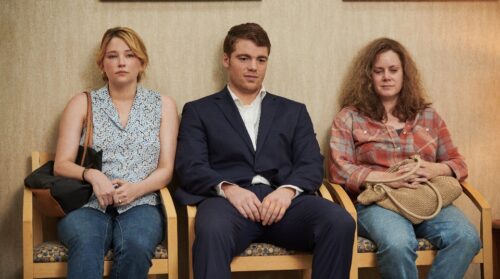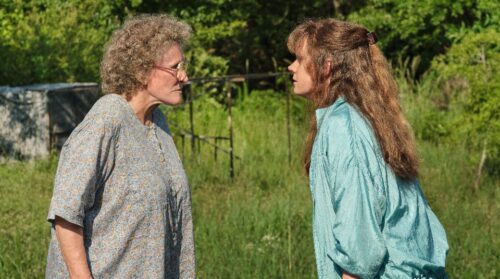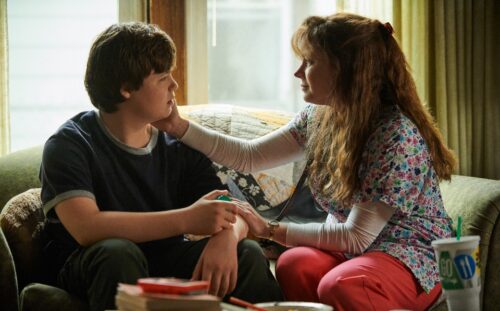
Netflix’s Hillbilly Elegy is based off the memoir and true-life events of J.D. Vance. The film is directed by legendary director Ron Howard, which includes genuine performances from Amy Adams as Bev, Glenn Close as Mamaw, Gabriel Basso as older J.D. Vance, and introducing Owen Asztalos as young J.D. Vance. Hillbilly Elegy deals with J.D. as he grapples with deep family issues stemming back three generations from a small town in Ohio from his grandmother, mother, and down to him and older sister. The film shifts back and forth from younger J.D. to present older J.D. attending law school at Yale University. One of the major attributors to the story style and perspective is editor James Wilcox (Genius, Hawaii Five-0, CSI: Miami).
The editing reflects the perspective through the eyes of J.D. Wilcox echoed, “We needed to experience this story from J.D.’s younger eyes and through his older self. I cut everything in point of view and then reveal that it was J.D. I constantly kept a barometer on not being too wide to show what’s going on, but being in his shoes in the point of view of the photography to experience what was going on. This was a conscious effort to shoot and edit it that way. If we put that story together in a different way, it becomes a little less experiential, and more observational. We have to really empathize with those characters.”

The film was scripted with intercuts bouncing back and forth when J.D. was 13 in 1996 to 28 in 2011. “The key on a lot of the cross-cuts is to have the audience follow the timeline emotionally, the events that are happening across those cuts is the transitions. When concluding the gas station scene, we needed to get back to young J.D. sitting in the back of the cop car. In that cut, we would see that this guy has been dealing with a lot of emotional baggage from the family for essentially his whole life and it represents a 15-year difference. More so than anything, it’s the emotional connection. If we understand emotionally where he’s at all times, it’s much easier to process the time jumps. Some of it was designed style wise. When we have dual time periods going on, those transitions become extremely important in the storytelling. If the audience is lost for any length of time, then they spend time catching up and usually miss the top part of a scene that is informative. We tried to do it a number of different ways where the connections were made, but not always predictable,” the editor described.
The performances of Amy Adams and Glenn Close drove the impact and steered the editing of the scenes. “These two are such unbelievable, courageous, brave, and deeply committed actresses. Initially, when I cut Amy first, I liked her when she’s really edgy. I discovered I had built her too edgy too quickly and hadn’t established enough likability with her as a mother, as a character who she was, just to get to know and understand her because she was going to have multiple flare ups down the road. We needed to start with Amy in a place where we were all on board and understood her son comes back from the fight down in the swim hole and show that she’s a protective mom. I toned her back, so that we had somewhere to build to. Glenn did such amazing physical work because Mamaw had a bad hip and she was a chain smoker. Mamaw, the character had a voice that was much older and gruffer than Glenn Close’s natural speaking voice. With Mamaw, it was all in her eyes, her reactions, and in her looks. Both of those roles are very flawed but really deeply human characters that people relate to,” the editor commended.

The scenes with J.D. and with his mom differed from those between J.D. and his grandmother. Wilcox compared, “J.D. loves both of those characters greatly, they’re very influential in his life. His mom is struggling with addiction and some personal issues that she should have gotten some help for. The mother is under a lot of pressure because she’s one of the few who’s pulling in an income in the family and the father is not around. His mom was volatile and he loved her. My interpretation of him loving his mother was all about trying to repeatedly support and understand his mother, which is another way of loving someone.”
The editor continued, “As far as young J.D. and the scenes with Mamaw; it’s so emotional, we could see she was the real anchor in his life. She was the one who gave him a swift kick in the butt and at the same time gave him a hug, and she did it verbally. In the movie, she’s not characterized as being very touchy feely, but we know her love comes across for him. There are two scenes that really touched me a lot. The Meals on Wheels scene that shows us how much she really loves him, she is begging the Meals on Wheels guy for more food and she’ll take whatever that amount is. After she gets it, it greatly affects him because now he really sees he’s been screwing up and that someone loves him so much that they’re willing to beg, run short on medicine, and then sacrifice food for him, who’s moved in with her. In the car scene, she tells him, “you got to decide because people like us don’t really get a lot of chances in life; you need to go to school, you need to get good grades, you need to do everything you can just to get a chance.” That is the most universal speech that I’ve heard in a long time and audiences really connect with that.”

Near the end of the film J.D. has an epiphany which displays various imagery from previous scenes with the addition of unused material. “There were parts of the imagery that were not in the movie, that were designed for the flashback when he went to the military and he got his haircut and several other moments. I started just thinking what were the most emotionally resonant parts of the film that wouldn’t feel too redundant and that would really give us a sense of the push and pull that he had to make his decision. What’s really underneath driving all of that montage is the duality of I’m drawn towards my mom, but then that comes with a price. Then all the things that Mamaw taught him and what that meant going forward, how would these moments impact his decision to move on, that’s the best way for me to help this family. Hopefully audiences got that out of it, that there were good times and troubling times with his mother. The same thing with his grandmother where she had moments, she was proud of him, where she had reminded him of all the things that are really important in life and how he was standing on his own two feet,” the editor summarized.
Hillbilly Elegy reflects the perspective of the true events and memoir of J.D. Vance. The film journeys with J.D. as he wrestles with family hardships throughout his life with an attempt to succeed and move forward. The editing captures the point of view through the eyes of J.D., showcases genuine performances from Amy Adams and Glenn Close, provides a sense of connection and relatability for the audience, and generates some hope in overcoming adversity to succeed in life.
Hillbilly Elegy is now streaming on Netflix. All pictures courtesy of Netflix.





